 The event included an additional speaker, Nguyen Hoan of the South Vietnamese embassy in Washington. |
Opponents of the war disrupted the event. In doing so, they took the first step towards the cancel culture that has overtaken campus life, with faculty and students alike now being investigated by star chambers before being fired or expelled for the sin of holding the wrong views. Similarly, the strong words and weak actions of Harvard's leadership foreshadowed cowardly conduct of university administrators who speak bravely but act with pusillanimity.
The Event
The Counter Teach-In stood out as "the first significant Harvard political event to be initiated by conservative students in more than five years" explained the student newspaper, the Harvard Crimson. Organized as Students for a Just Peace (SJP), our hardy little band invited five speakers to explain why U.S. forces should support South Vietnam's government: Dolph Droge, a White House adviser on Vietnam; Anand Panyarachun, Thailand's ambassador to the United Nations; Nguyen Hoan of South Vietnam's embassy in Washington; I. Milton Sacks of Brandeis University; and Daniel E. Teodoru of the National Student Coordinating Committee for Freedom in Southeast Asia. Lawrence McCarty of the American Conservative Union agreed to moderate the event.
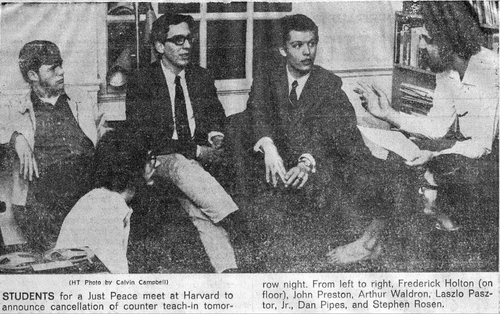 A Boston Herald Traveler photograph on May 2, 1971, of six SJP members: from the left, John Preston, Frederick Holton, Arthur N. Waldron, Laszlo Pasztor, Jr., Stephen P. Rosen, and Daniel Pipes. |
Two groups stood out in the ferocity of their reaction: the Students for a Democratic Society (SDS; full name, the Students for a Democratic Society-Worker Student Alliance), proponents of sex, drugs, and rock 'n roll; and the largely forgotten Progressive Labor Party (PLP), dubbed "Maoists with crewcuts," strait-laced and vicious. Thus did New and Old Left make common cause against us "reactionaries."
Along with other leftist groups, they met and decided to interrupt the teach-in. In flyers that blanketed the campus ahead of the event, PLP asserted that the "stooges," "butchers," "lackeys," and "flunkies" scheduled to talk "have to be smashed." More prosaically, SDS merely called for them to be "clapped down and kept from speaking." Some radicals justified this response on the grounds that the U.S. government (and not we handful of students) had brought the speakers to the campus; one student even called the Counter Teach-In "a plot between Harvard and the U.S. Information Agency to show that the antiwar movement was dead."
Anticipating a massive response, the organizers reserved Harvard's largest hall, Sanders Theatre, capacity 1,238. Both SDS and PLP called for rallies at 7 p.m., an hour before the event was to start. Extremism researcher Gordon D. Hall reported in the Boston Herald Traveler that a majority of the audience came from outside Harvard, including much of the region's radical leadership. Such was the rage at our insolence to bring what both groups called "war criminals" that the hall filled up well before the starting time. Many more tried to enter, however; in the Boston Globe's description, "Hundreds of SDS partisans ... massed at the entrances and attempted to reach second-floor windows."
Many in the overwhelmingly hostile audience quietly expressed their views by giving the finger, wearing headbands, carrying Viet Cong flags, and waving signs with "MURDERER" and other slogans on them. About half disrupted by hissing, booing, singing, yelling obscenities, screaming into bullhorns, and rhythmically clapping hands. They shouted slogans, especially "Murderers" and "U.S. out of Vietnam, Butchers out of Harvard." They slammed the hall's wooden seats in unison open and shut, open and shut. They pelted the stage with marshmallows, spitballs, fruit rinds, pennies, and other small objects.
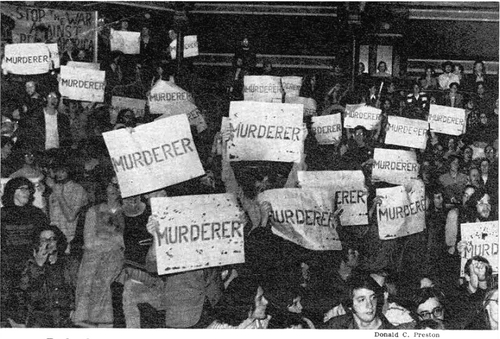 A Newsweek photograph showed some of the many "MURDERER" signs at the Counter Teach-In. |
The speakers never had a chance. A wall of noise shouted down the three who tried to address the audience: the moderator, a university representative, and the first speaker. (For a 41-minute audio recording of the event, click here.) Archibald Cox, 59, a former solicitor general of the United States (and later of Watergate's Saturday Night Massacre fame), served as Harvard's trouble-shooter at the event. Representing the university in a much-admired and -cited statement, he beseeched the crowd "to let me say a few words in the name of the President and Fellows of this university on behalf of freedom of speech." But it did not relent and continued with the racket. His plea – "if this meeting is disrupted ... then liberty will have died a little" – went unheeded and scorned; PLP later condemned the very concept of free speech as a "rotten idea."
The first speaker, Dan Teodoru, tried to fight fire with fire, a tactic that failed. In the words of the official Harvard inquiry, "The din continued and various missiles were thrown at him from the audience, at least one of which he returned in kind." He also tried to shame the audience by calling it names, also to no avail; the racket and chaos continued for 45 long minutes.
The Harvard inquiry recounts how the event came to an end: "During the latter part of the meeting, individuals who had been prevented from entering the Theatre by the University Police when the hall seemed full began to pound on the fire exits seeking entry and broke several windows to gain entry, raising the possibility of further violence. At about 8:45, the meeting was cancelled at the request of Professor Cox, speaking for the University." His precise words: "In view of the crowds of people, there is a considerable risk of violence. I ask you to stop this meeting." More colorfully, the PLP reported a battering ram being readied to break down the theater's doors.
A half dozen Harvard police escorted the speakers out of the building and through the university's elaborate underground steam tunnels, just as they had done with then-Secretary of Defense Robert McNamara a few years earlier. SJP organizers shepherded the speakers to radio station WGBH, which had broadcast the event, and there, in the studio calm, they began their interrupted conversation.
Had the theater not been filled with an overwhelmingly hostile crowd, it bears noting, the radicals had a more violent scenario in mind, as revealed by Hall, who gathered intelligence on their preparations: "A smaller turnout might make it necessary to rush the stage and forcibly take control of the teach-in." Had that happened, the radicals intended to swarm the stage; "the crowding shoving, and yelling would make it difficult for anyone to single out a particular individual. The chaos would also be enough to gag the speakers, confuse the police, and break up the meeting." The Counter Teach-In speakers, according to PLP, were "mass murderers (imperialists!) and architects of terrible suffering who have no right to live, let alone speak." In other words, the evening could have turned out far, far worse than it did.
Legitimate or Odious?
The fracas shunted debate over Vietnam policy to the side, replacing it with a clash over the radicals' actions and the nature of free speech.
Arguments favoring the disruption came exclusively from narrow precincts of the hard left and focused on two issues, morality and power. Morality: The speakers had the blood of innocents on their hands and therefore had no right to speak. Power: The speakers represented authority and disrupting them, wrote two students, "provides the chance for powerless individuals to affect the course of political events." A minority editorial in the Crimson downplayed the disruption as a mere "transgression of the laws of protocol and order."
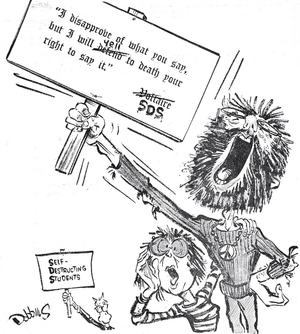 James Dobbins' editorial cartoon in the Boston Herald-Traveler on Mar. 30, 1971, reflected the consensus view of the disrupters as uncouth loudmouths. |
Some commentators called the disrupters totalitarians. Historian Oscar Handlin called the disruption "the shriek of savages" and compared the "hate visible" on the ringleaders' faces to "hate we have seen on too many other faces, in other times and other places - say in Germany, November 9, 1938," a reference to the Nazi Kristallnacht. Likewise, Globe reporter Daniel J. Rea reported from the event on seeing "the facial vacuity that personified the Hitler Youth of the 1930s and Mao's Red Guard of the Great Cultural Revolution." Cornelius Dalton of the Boston Herald Traveler compared the disrupters' tactics to "those used by Nazi storm troopers" and called the incident "The most damaging blow to the cause of peace in a long time."
Several professors emphasized the seriousness of the disruption. The physicist Bruce Chalmers, 63 at the time, noted: "The seriousness with which you view this incident depends very much on your age. The older you are, the more serious it was for you." Cox said he "couldn't overemphasize the seriousness with which we view this incident. Nothing more important nor sad has happened here at Harvard for a long, long time." John T. Dunlop, dean of the faculty of Arts and Sciences and a former secretary of labor, stated that "The disruption of the teach-in was the most serious thing to happen at Harvard since I've been here." (He had arrived in 1938, 33 years earlier.)
As a sign of the faculty's extreme upset, Dean Dunlop sent to faculty members an unusual and possibly unique memo in the history of Harvard, urging them to raise the freedom-of-speech topic with students: "Public statements alone are not adequate. Quiet and reasoned discussion with individuals is required to influence our students. Many students, and even some members of the teaching staff, do not accept the proposition that academic freedom requires the free expression of any views. ... I hope that you will take some time in the days immediately ahead to discuss with students ... these momentous issues."
Punishment?
On the practical level, university administrators took two steps against the disrupters: bringing criminal complaints against two in a Cambridge court and initiating internal proceedings against them by a Harvard body known as the Committee on Rights and Responsibilities (CRR).
The Third District Court quietly found two students guilty of disruption and sentenced them to jail terms. CRR hearings and verdicts were far more contentious, becoming the key battlefield from the instant the Counter Teach-In ended on March 26 until the CRR handed down its verdicts 70 days later, on June 4. In an editorial, the Crimson hammered the CRR hearings as a "witch hunt" comprised of "shoddy evidence, vague testimony, slipshod procedures, and indifference to truth." Future Washington Post editor and columnist David Ignatius urged "no punishment." Thirty-two faculty members signed an open letter stating "any punishment by the University would be unacceptable."
Those in favor of throwing the book at the disrupters included Elliott Abrams, most recently the U.S. special envoy for Venezuela and Iran, who wrote: "We must refuse to beg for free speech at Harvard. We must insist upon it. ... to sit quietly by while gangs of stamping and screaming extremist thugs destroy free speech at Harvard is a moral crime. ... We must demand their expulsion from our University." Future presidential candidate Alan L. Keyes argued that the disrupters "must be punished with all the severity which the University has at its command."
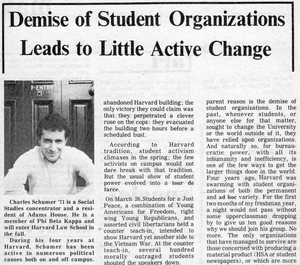 Excerpt of an article by Charles Schumer in the Harvard Independent, May 27, 1971. |
In the end, the CRR found a mere nine students guilty of disruption, about 1 percent of those who interrupted the meeting. Of those nine, four were required to withdraw temporarily, three had a suspended withdrawal, and two received warnings. SJP requested that the leftist groups which planned the disruption be permanently banned from use of university facilities; in response, the administration denied this appeal on the grounds that "there has been no finding that these 'organizations' have prohibited the exercise of free speech."
In other words, penalties were limited to the symbolic; harsh words, references to high principle, and warnings about the future did not translate into action. Harvard's response was as rhetorically tough as it was substantively weak. In this sense, Stephen P. Rosen, then a freshman SJP member and now the Kaneb Professor of National Security and Military Affairs at Harvard, correctly predicted days after the event that the froth of outrage would soon pass: "You mark my words, when this sudden wave of righteous indignation passes, the university will forget all about [the Counter Teach-In] last weekend. Spring will move in on us, the school semester will end, and life will go on as usual, as though nothing really happened."
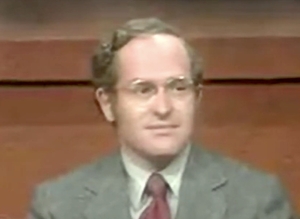 Alan Dershowitz in 1970. |
The third chargee, McKean, was a student at the Graduate School of Education, therefore that faculty's professors ran his hearing, which was even more frustrating than the CRR. I complained about my experience with it to the education school's dean:
At the hearing which the Student-Faculty Committee on Discipline conducted on 20 May, Mr. McKean did not deny taking an active part in the disruption, but, rather, he claimed pride in his actions. Consequently, he did not choose to defend himself from the specifics of my charge, but justified his conduct on a political basis, asserting that the nature of the Counter Teach-In made disruption necessary. I was distressed that the Committee on Discipline chose to hear Mr. McKean's political arguments because my charge was directed towards an act of misconduct unrelated to politics.
My plea fell on deaf ears; McKean received no punishment.
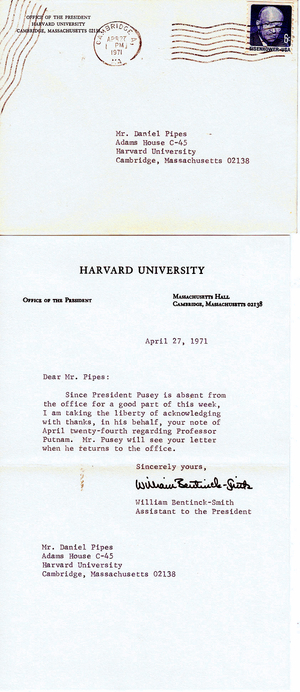 Letter from William Bendick-Smith, assistant to President Nathan Pusey, to Daniel Pipes, Apr. 27, 1971. |
The Counter Teach-In remained a topic of discussion, coming up in a 1971 House of Representatives hearing on the PLP by the Committee on Internal Security. In his 1998 book, Harvard Observed, John T. Bethell called it "an ugly breach of academic freedom." In a 2016 study on anti-conservative bias in universities, Passing on the Right: Conservative Professors in the Progressive University, Jon A. Shields and Joshua M. Dunn Sr., cite an unnamed history professor who, as a student
drifted rightward after confronting the political intolerance of the campus left in the 1960s. He and his friends attempted to organize a "Counter Teach In" on the Vietnam War. ... It did not go well. "People harassed me," he said. "[I]t was a really searing experience." By his senior year he reluctantly came to accept that he no longer had a home on the left.
Who Won, Who Lost?
Which side won and which lost at the Counter Teach-In?
In the immediate term, the radicals gained a tactical success in closing down the event, something they openly crowed about: For the PLP, "Forcing these imperialist creeps to leave with their tails between their legs is a tremendous victory." SDS called the disruption "a clear political defeat for the US government and the Harvard administration." Within the month, radicals produced a celebratory movie titled "Sanders Theatre Victory."
Looking at the larger picture, a wide consensus emerged in the spring of 1971 that the bad behavior had damaged the radicals' cause and helped the pro-war side. As one student wrote to the Crimson, thanks to the disruption, event organizers "got much more mileage out of the disruption than they would have from their speeches." Indeed, we did. Lengthy, learned articles appeared, along with a reference on the front page of the New York Times. One plaintive member of the audience spoke for the silent participants in ruing the disruption because he went to listen and learn, something that the left had denied him. He concluded that "The only thing the left may have gained by shouting down the speakers was to alienate some of the people there whose opinions weren't formed yet." The New York Times reported that "a majority of students seem to feel that the disruption was deplorable both as an immoral act and as a tactical blunder."
The sociologist Barrington Moore, Jr. agreed, castigating the radicals for inadvertently aiding "a politically and morally bankrupt cause." Aryeh Neier, the head of the American Civil Liberties Union, rejected the disruption's "dangerous and counterproductive tactics." In this spirit, Newsweek called the radicals' victory "Pyrrhic." New York Times columnist Lewis opined that supporters of the war in Vietnam "will be hoping for just such excesses." The Boston Globe concluded that the disrupters "immeasurably hurt" the effort to end the American war in Vietnam.
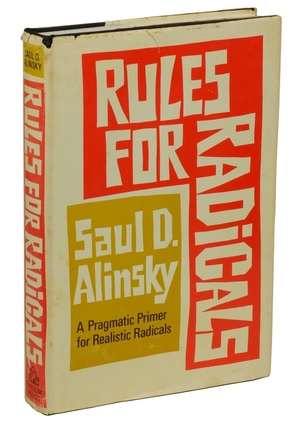 Saul Alinsky's Rules for Radicals coincidentally appeared in 1971. |
The way radicals now see an institution like Harvard demonstrates this shift. In 1971, they portrayed the university as the enemy in a way inconceivable in 2021. PLP declared that "Harvard, like all universities, serves only the ruling class." SDS agreed: "The university stands behind the 'right' of butchers" such as Henry Kissinger, Samuel Huntington, and Richard Nixon. PLP placed an ad in the Crimson asking, "Is Harvard University an open forum for ideas, as the administration contends, or a command post for imperialism? Who should be kicked out? ... We say: Kick out war criminals like Huntington and Kissinger." PLP and SDS jointly accused the university administration of wanting "freedom for themselves to continue exploiting and oppressing the people of the world." As PLP put it, "Harvard acts here [in Cambridge] and all around the world to deprive working people of everything, including their lives." Hating capitalism and oblivious to facts, PLP even referred to Harvard's "billionaire deans," a bizarre description at a time when the United States had no billionaires and the Harvard endowment itself had just recently passed the billion-dollar mark.
, no leftist would make such statements, for universities fuel the left's ideas and serve as its arsenal. Thus did that long-ago event help pave the ways for the monochrome leftist university of today. SJP co-leader Arthur Waldron, now Lauder Professor of International Relations at the University of Pennsylvania, perceptively noted in 1971 how "the repressive spirit of the left has led many professors to 'trim their sails'." This proved an enduring pattern that goes far to explain the cowardice of the professoriate today.
Charles Lipson of the University of Chicago notes that no one on today's campus advocates genocide, slavery, or child molestation but, rather, "unpopular views on topics such as merit-based admissions, affirmative action, transgender competition in women's sports, abortion, and support for Israel." While these are all legitimate topics in the country at large, "Not so on college campuses, where the 'wrong views' are not just minority opinions. They are verboten, and so are the people who dare express them. Challenging this repressive conformity invites condemnation, severs friendships, and threatens careers. It is hardly surprising that few rise to challenge it."
Just days after the CRR report came out, Nathan Pusey gave his final commencement speech as president of Harvard. He recalled the great hopes for universities in 1945 and their accomplishments, then added a somber note:
So we dreamed and so we worked. The effort has not come out exactly as we had hoped. At least not yet. But now a change has occurred and, as so frequently happens with the weather, the change was accompanied by storms. Universities are no longer universally admired. Indeed some people have even come to look upon them less as saviors than as the source of evils from which society must be saved. The general public evidences less esteem for university faculties. ... There can be no doubt that we are entering a new, very different, and, it appears, a very troubled period in higher education.
Pusey concluded by noting that "Because so many currently question the value of universities ... it would be easy to feel gloomy about their prospects." And those many would be right.
Mr. Pipes (DanielPipes.org, @DanielPipes) graduated Harvard College in 1971. ©2021. All rights reserved.
Addenda
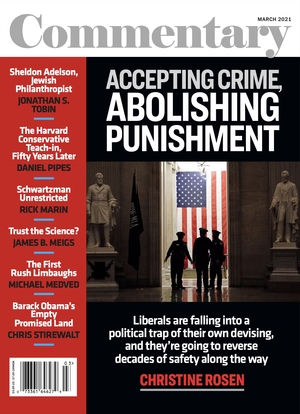 1. For further documentation: (a) a 41-minute audio recording of the Counter Teach-In, here; (b) Harvard's three-minute film of the event, here; (c) written documentation including press clippings, university statements, flyers, letters, here; and (d) my next-day blow-by-blow account of the event, here.
1. For further documentation: (a) a 41-minute audio recording of the Counter Teach-In, here; (b) Harvard's three-minute film of the event, here; (c) written documentation including press clippings, university statements, flyers, letters, here; and (d) my next-day blow-by-blow account of the event, here.
2. Charles Schumer ridiculed disrupters who tried to avoid the consequences of their deed: when in legal proceedings, "most of the disrupters now seemed to focus their moral outrage on petty legal issues; when accused of chanting at 8:22 p.m., the protester's ire rose because he was really chanting at 8:24 p.m." PLP agreed with him, also condemning the cowardice of claiming "'I just chanted "Let the butchers speak",' or denied that they had chanted very much, or something similar."
3. In contrast to today, the Left in 1971 hardly mentioned Israel, the Palestinians, the Middle East, or Islam. Contrarily, a PLP flyer used language completely alien today, such as declaring the "Workers' Dictatorship the Only Solution." Another called for "the international working class and its allies [to] destroy the bourgeois class completely." Classic goals like workers' dictatorship or destroy the bourgeois class have been replaced by the more reasonable-sounding and insidious goals of transgender rights and Black Lives Matter.
4. The insipid response to the disruption in March 1971 contrasted with two years earlier, when Pusey called the police to eject the occupiers of an administrative building in April 1969. Deans forced from their offices clearly mattered much more than debating the Vietnam war. Waldron sees in this contrast the collapse of the university's mission. "Suppose that, instead of trampling freedom of speech, the mob had tried to break into the museum to smash ancient vases and slash Renaissance paintings; the university reaction would have far tougher. But surely destroying rights is worse than destroying artifacts. The university had already changed in 1971, and this change then steadily continued. No truly intellectual institutions exist any longer."
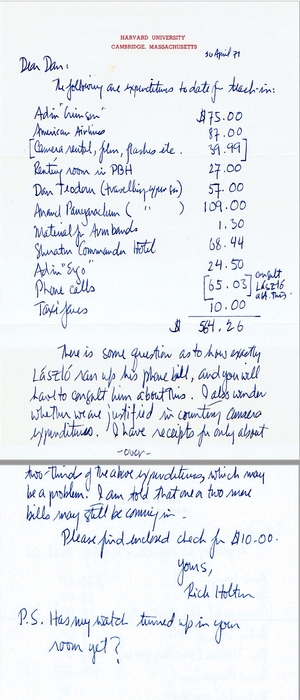 Letter from Frederick Holton to Daniel Pipes detailing the Counter Teach-In expenses, Apr. 20, 1971. |
6. Conversely, an oddity in researching this paper was finding that a number of individuals conspicuous due to the Counter Teach-In thereafter disappeared. For example, nearly all search engine citations for John T. Berlow and Daniel E. Teodoru date from circa 1971.
7. Laszlo Pasztor, Jr. and Arthur N. Waldron co-chaired the SJP. The small band also included Peter Barzdines, Douglas Cooper, Frederick Holton, John Moscow, John Preston, and Stephen P. Rosen. I served as treasurer and can report that the entire undertaking cost $564.26; not much, even in 1971 dollars.
Apr. 8, 2021 update: The Harvard Crimson has published a follow-up piece to this article, by Sarah W. Faber and Vicki Xu. "Harvard's 'Marshmallow Revolution,' 50 Years Later." It provides new information by interviewing three of the disruptors, Bonnie E. Blustein, E. John Pennington, and James P. Stodder, all of whom are fiercely proud of their actions in 1971. In addition, they got comments from Arthur N. Waldron and myself.
Perhaps the most amusing tidbit is this:
Pipes brouJulyght charges in a court created by Harvard in the wake of heightened campus activism, the Committee on Rights and Responsibilities, against Blustein and two other students — Martin H. Goodman '70 and John W. McKean '71 — for disruption. "The case against Blustein is memorable because I was grilled at length by a 32-year-old Alan Dershowitz," Pipes wrote in a blog post this March reflecting on the 50th anniversary of the demonstration. "The future celebrity professor of law successfully deployed his formidable legal skills to convince the CRR that his client was innocent of the disruption I personally witnessed."
Because this was an intra-university hearing and not a legal case, Dershowitz likely volunteered his services — unbeknownst to his defendant, Blustein. She says she was never notified of the hearing regarding the events at Sanders Theatre, and was acquitted in absentia. "I never had anything to do with Alan Dershowitz, and I hope I never do," Blustein wrote in an email.
July 22, 2024 update: Graffiti near the Harvard campus points to changes since the Hamas attack on Oct. 7. I wrote 3½ years ago that "The way radicals now see an institution like Harvard" had shifted over the half century: "In 1971, they portrayed the university as the enemy in a way inconceivable in 2021." Well, it's again conceivable in 2024, as succinctly summed up in this photograph.
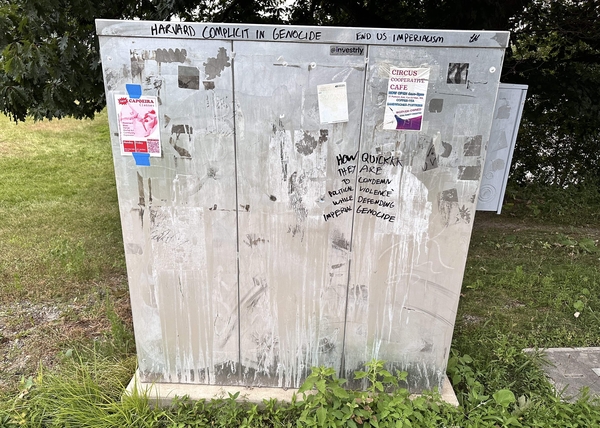
July 25, 2024 update: This headline, "Harvard University Grants Degrees to Pro-Hamas Protesters, Says Students 'Restored to Good Standing'," reminded me of my experience in 1971.
Aug. 20, 2024 update: Rep. Virginia Foxx (Republican of North Carolina) chairs the U.S. House's Committee on Education and the Workforce. She reports, based on information from Columbia University, that:
18 of the 22 students arrested inside Hamilton Hall are now in good standing, while three are on interim suspensions and one is on probation.
Of the 40 students arrested by the New York Police Department on April 18 for participating in the first Columbia encampment, one is on disciplinary probation, 21 are in good standing pending a hearing, and 18 had their standings cleared through a form of alternate resolution.
Thirty-one of the 35 students who were originally placed on interim suspension for failing to leave the second Columbia encampment were restored to good standing after the university said it couldn't substantiate that they were participants. Two students are on interim suspension from previous incidents, while one is suspended and another is on disciplinary probation.
For me, this is an old story.